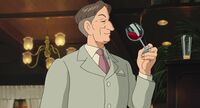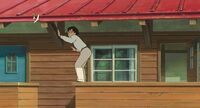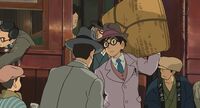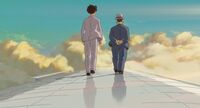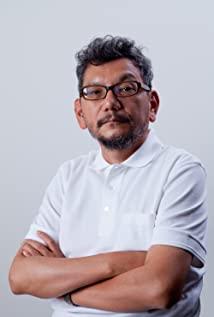The story itself is a story about dreams and beauty. As Erlang said: "ただ, 美しいものを作りたかった" (I just want to design something beautiful) In the planning book of this film, I also wrote: "All the beautiful pictures を Zuo りたいです" (I want to make a a beautiful film). Director Hayao Miyazaki himself has also been interviewed and mentioned: "I just try my best to make a beautiful animated film, but I am lucky that my film is popular with the audience and has a high box office." Some people like to say that this film is a Whether it is anti-war or glorifying war has any deep political meaning. I think maybe Hayao Miyazaki's purpose in making this film is very simple, he just wanted to make an animation that he thinks is beautiful.
-------------------- -The following is the official website public plan, there are minor dramas to be cautious ----------------- --
[Proposal published on the official website]
The first part of
the plane is a friendship beyond time and space between Jiro Horikoshi, the designer of the beautiful Yume
Zero fighter, and Giovanni Caproni, an Italian senior engineer with the same dream. The two of them overcame setbacks and pushed hard toward their boyhood dreams with all their might.
In the Taisho era, a boy who grew up in the countryside was determined to become an aircraft designer. Dreaming of making a plane as beautiful as the wind.
Soon the boy went to a university in Tokyo for further studies, became a top engineer in a large military enterprise and showed his talent, and finally designed a beautiful airframe that has been famous in aviation history. The Mitsubishi A6M1, the Navy Zero carrier-based fighter later referred to as the Zero Warfare.
In the three years from 1940, Zero became the preeminent fighter in the world.
From adolescence to adolescence, our protagonists live in a time more turbulent than today's Japan, which pervades a sense of isolation. The Great Kanto Earthquake, the world economic crisis, unemployment, poverty and tuberculosis, revolution and fascism, speech control and wars, on the other hand, the blossoming of popular culture, modernization and nihilism, and hedonism are rampant. This is a time when poets fell ill and died while traveling.
The era of our protagonist's involvement in the design of the fighter jet was a process in which the Japanese Empire continued to advance toward self-destruction and, ultimately, its collapse. However, this film is not about fighting war. Nor is it to inspire young people in Japan with the excellence of the Zero fighter. I also don't intend to maintain it with excuses such as "actually I wanted to build a civilian aircraft" (Jiro).
This film wants to describe a man who is faithful to his dreams and moves forward bravely. There is madness in dreams, and its harmful side cannot be hidden. The longing for beautiful things can also become a trap in life. The price of intoxication with beautiful things is not much. Erlang suffered setbacks, his heart seemed to be torn apart, and his life as a designer was terminated. (Author's Note: It should refer to his post-war state of mind that he wanted to design a beautiful plane but couldn't design and manufacture it.) Even so, Erlang is outstanding in originality and talent, which is what this film wants to show.
The title of the film "Feng Li ち ぬ" is taken from Tatsuo Hori's novel of the same name. Hori Tatsuo translated a stanza in Paul Valery's poem into "Wind Li ちぬ, いざ生きめやも" (author's note: The literal translation of this translation is "The wind is blowing, if you want to live hard, the fear is to achieve." No way” and Valery’s original poem “Only try to survive” has a certain difference, adding a sense of helplessness.) This film brings together the historical truth Jiro Horikoshi and the writer Hori, who lived in the same era. Chenxiong blended together and created a protagonist "Erlang". It is a film based on the birth of the Zero fighter, which is regarded as a myth by later generations, and the acquaintance and separation of the young engineer Jiro and the beautiful and unfortunate girl Nahoko as the horizontal line. A totally fictional and unique piece of youth in the 1930s.
Part II
Memo on Imaging
The most beautiful display of the green Japanese climate from the Taisho to the early Showa period. Clear blue sky and white clouds, transparent spring water, and a pastoral garden with no garbage at all. On the other hand, the city is very poor. Buildings do not want to use dark brown, try to show the colorful colors of modern East Asia. The roads are potholed, billboards are erected in disorder, and wooden poles are everywhere.
The parts of the protagonist from juvenile to youth and finally middle age must be made in biographical form, but the designer's daily life should be very simple. To keep the confusion of the audience to a minimum, bold temporal cuts had to be employed. This movie should be a combination of three types of images.
Everyday life is realized by accumulating rustic descriptions.
In the dream, the most free space, full of sensory stimulation. Time and weather are constantly changing, the earth is undulating, and flying objects float slowly. This shows Caproni and Erlang's madness and paranoia about their dreams.
Technical commentary and exaggeration of the meeting. Although I don't intend to talk about the expertise of aviation technology at length, I don't hesitate to caricature when necessary. There are always many meeting scenes in movies of this theme, which is a common problem in Japanese movies. But individual fates are sometimes decided by meetings. Although the scene of the meeting is not planned in this work, if the plot requires it, make it comic and interesting, and omit the lines. Personally, I still have to draw.
Wanted to make a movie that was realistic,
fantastical,
comical at times, and
overall beautiful.
The above is the plan published on the official website of "Feng Li ち ぬ", the author's own translation version.
Any similarity is purely coincidental.
----------------------------- Serious spoilers below --------------- -----------------
[Incomplete sorting of the story and background of the film]
Since I only watched it once, there are some omissions in the plot, so I roughly recall the incomplete version:
1903 (Meiji 36)
Birth of Erlang
(No performance in the film, in the same year the Wright brothers made their first successful powered flight.)
1914? (Taisho 3 years)
Erlang should be in elementary school when he was 11 years old.
I dreamed of Uncle Caproni and aspired to become an aircraft designer.
On September 1, 1923 (Taisho 12),
at the age of 20, Erlang studied at Tokyo No. 1 High School or the University of Tokyo at the age of 20.
On the train from her hometown back to Tokyo, she meets the heroine Nahoko. After experiencing the Great Kanto Earthquake together,
Erlang helped Nahoko and her injured servant to return to their families, but there was no progress between the two.
In 1927 (Showa 2),
Jiro was 24 years old and joined Mitsubishi Internal Combustion Engine Manufacturing Co., Ltd.
(Author's Note: Mitsubishi Internal Combustion Engine was manufactured and renamed as Mitsubishi Aircraft. After merging with Mitsubishi Shipbuilding, it became Mitsubishi Heavy Industries. The protagonist should have gone to the Oe Factory in Nagoya Port Area, which is now the Oe Factory of Mitsubishi Heavy Industries Nagoya Aerospace Systems Works.)
In 1928 (Showa 3),
Jiro was 25 years old and participated in the development of the Hayabusa prototype fighter (1MF2) developed by Mitsubishi. The prototype aircraft disintegrated and crashed during the test flight.
(Author's Note: Historically, in 1927, the Japanese Army asked several aircraft manufacturers, including Mitsubishi, to bid for the development of the main fighter in the future. During the test flight in 1928, the aircraft disintegrated during the rapid descent due to insufficient airframe strength. Test flight Jun
Zhongao successfully escaped by parachute and became the first person to escape from an airplane by parachuting in the history of Japanese aviation. The film also faithfully restores this plot)
In 1929 (Showa 4),
Jiro was 26 years old and went to Germany with a group. Cox company inspection.
Afterwards, he went west through the United States and other places to circle the earth to increase his knowledge and then return to China.
(Author's Note: Junkers' full name is Junkers Aircraft and Engine Factory, a German aircraft manufacturer. In World War I, the most advanced all-metal monoplane was manufactured at that time. Its founder was Hugo Rong Dr. Junkers in the film. Later, he was placed under house arrest for opposing the Nazi party, and the company was taken over by the Nazis. This is also mentioned in the film. They should inspect the largest passenger aircraft G developed by Junkers at that time. The same type of K.51 heavy bomber as .38. Historically, Mitsubishi purchased the production copyright of the aircraft and developed and tested the Type 92 heavy bomber that did not participate in actual combat.
In 1932 (Showa 7),
Erlang was 29 years old and became the seventh test carrier. Chief Designer of the Fighter.
(Author's Note: The first Shanghai Incident occurred in this year, namely the Songhu War of Resistance on January 28. When Erlang and Honjo opened the box containing the parts, they could see the "Shanghai Incident" written as a buffer material. newspaper.)
In 1933 (Showa 8), the
30-year-old Jiro
crashed during the test flight of the fighter jet on the seventh test ship. Frustrated, Jiro goes on vacation to Karuizawa in Nagano.
Meet and fall in love with Nahoko again, and make a marriage contract. After Erlang returned to Nagoya, he began to take over
the work of chief designer of the nine-trial single-seat fighter (later the Type 96 carrier-based fighter). Nahoko
decided to go to Fujimi Takayama Sanatorium to recuperate after she coughed up blood because of tuberculosis.
In 1934 (Showa 9),
Erlang Nahoko left the sanatorium at the age of 31
, and married Erlang and lived with Erlang under the witness of Erlang's boss Kurokawa and his wife.
In 1935 (Showa 10),
Erlang 32 years old and
nine test single-seat fighter No. 1 were completed, and they were transported by ox carts to Gowuyuan Airport for test flight.
On the day of the test flight, Nahoko may feel that she has not much time, so she left a letter and got on the train to leave Nagoya (it should be back to the sanatorium).
On the test flight field, everyone rejoiced with the success of the test flight, but Erlang also vaguely sensed Nai Suiko's departure.
(Author's note: At that time, there was no airport runway next to Mitsubishi's Dajiang factory for test flights, so after the aircraft was produced, it had to be split into several parts and transported to more than 40 kilometers away by land vehicles such as ox carts in 24 hours. The final assembly takes place at Gogohara Airport in Gifu. During World War II, this inefficient method was used for small aircraft, including the Zero, until Ofu Airport, which belonged to Mitsubishi Heavy Industries, was built in 1944. This part of the car also reproduces the historical facts of that year.)
In 1945 (Showa 20),
Jiro was 42 years old and
Japan was defeated. Among the scraps of scrap iron and iron wreckage, Jiro walked alone.
The last scene, which Yumi Matsutani evaluated as indescribable in words, begins here...
[Miscellaneous feelings]
1. Do your best to live
a wonderful animation There are many things to watch, and there are many things for viewers to comment on. Video, music, dubbing, sound effects, characterization
, narrative structure, and more. Before commenting on these, what I felt was the importance that director Hayao Miyazaki passed on to me through the story of Erlang to "live as much as possible". As a literary work, it will definitely be mixed. What is important to me is not the comments of others, but the thinking and touching brought by watching the film itself, and I will always cherish such an emotion.
In the turbulent Showa era, Erlang always carried out his dream of designing a beautiful aircraft. From fateful encounter to fateful reunion with Nahoko, fall in love, get married, and then die. Although I don't know how long they will be together, there is a strong bond and a strong love between the two who are still going forward. Both send me the message of "living as hard as you can".
Just like the lines in the film:
"Strength を do く し て 生 き る" (use all your strength to live a wonderful
life) "live き て" (live)
"live き れ ば" (you must live well)
Yes, I am still alive, live in this peaceful age.
I have to work harder than ever to live a wonderful life.
until the end of life...
2. About
the scenes in Japan and around the world:
The film follows the trajectory of Erlang's life, showing scenes in Japan and different parts of the world at that time.
Starting from Fujioka in Gunma, Tokyo, Nagoya, Gifu, Kagura, Nagano Karuizawa, Nagano Fujimi, Soviet Union, Germany, Italy in dreams, etc. The geographical features, architectural styles and natural landscapes of various scenes are very different. It is also a visual feast for the audience.
A large number of aircraft debuted:
from Caproni's Ca.60 to Junkers' K.51 to Mitsubishi's Falcon, seven test carriers, nine test single-seat aircraft that have appeared in the real world, and then appeared in dreams aircraft. It can be called a visual feast for aircraft houses and weapon houses. No wonder some Japanese netizens jokingly called the film "Red Pig II".
Trains that change with the times: There are
a lot of trains in the film, and they pass by in a flash. It's hard to tell that the trains are different without looking closely. I didn't read it carefully enough, and it's worth watching it slowly after closing the disc.
The customs of the Showa era before the war:
from houses, streets, cars and ships, to clothing and cigarettes. All exudes a strong pre-war Showa atmosphere. This should also be the highlight of the film.
The Great Kanto Earthquake:
There is no actual war depicted in this film. However, it focuses on depicting the history of the Great Kanto Earthquake. At the moment of the earthquake, the transmission of seismic waves, the spreading fire, the chaotic crowd, and the ruins after the disaster. Although there is no direct cruelty, it makes the audience feel the impact of the earthquake through indirect depiction.
Sky and Wind:
Hayao Miyazaki's animation loves to show the sky and flight. This work is related to airplanes, and naturally, various pictures of beautiful blue sky and white clouds are indispensable. And the paper plane dancing with the wind, the picture of the plane flying into the sky naturally has the element of wind.
The love between Erlang and Nahoko:
From the resort in Karuizawa to the platform in Nagoya, from Nahoko's house in Tokyo to the house of Kurokawa, the boss where Jiro lives. There are many depictions of the two in love in the film. A lot of tear-jerking points were buried in it...
3. Regarding several characters and dubbing
, I heard Erlang's voice from Anno at the beginning, and my heart spit out: "It's a young man, why is the voice of an uncle?" But after a few minutes Also getting used to it. As an engineer, it is not very offensive for a technical house to have such a sound of integrity, honesty, and little emotional ups and downs. As a technical nerd, there are such engineers around me.
Nahoko (voice: Miori Takimoto) is naturally a better actor than the amateur Anno in terms of emotional grasp. It feels good. The cuteness and gentleness of Nahoko are shown.
Erlang's younger sister Kayo (voice: Shida Miku) when she called her brother: "Niinii" was very impressive. Kayo, a stubborn young woman who fights for her ideals with Shida, feels very good overall.
Erlang's contemporaneous Honjo (voice: Nishijima Junxiu) is more ambitious and outgoing in character, which is a good contrast to Erlang. But as an aerospace engineer, many thoughts and concepts are similar to Erlang. Some opinions about the "contradiction", another theme of the film, are also told to the audience through his mouth.
Erlang's boss Kurokawa (voice: Nishimura Masahiko) is a slightly happy character. It can be regarded as a good boss who understands and trusts subordinates and can give advice and help to them. Although the short man in the film is difficult to connect with the tall Nishimura Masahiko.
The German Kastrup (voice: Albert), whom Karuizawa met by chance, is also a very happy character. It can be regarded as the matchmaker who matched Erlang and Nahoko. The voice is Miyazaki's friend and former colleague, American Albert. He made a lot of contributions to the opening of the American market for Hayao Miyazaki animation, but as a seiyuu, he is also a layman like Anno. The image of the character is drawn with reference to Albert's face. It's also interesting that foreigners speak bad Japanese on purpose.
4. Music and sound effects and theme song
It is still the composition of his old partner Joe Hisaishi. The theme melody is relatively simple, and the soft theme melody in the 30-second trailer appears repeatedly in the film. When the plot climaxes, the melody also increases at the same time. In the German scene, some brass instruments are used to bring out the solemn atmosphere. In general, as the scene changes, the music also changes accordingly to highlight the atmosphere at that time.
As an experiment, the sound effects of this film, including the running of the train, the roar of the aircraft engine, the rotation of the propeller, and the seismic waves, are all realized by processing and synthesizing the sounds made by humans. In my opinion, the quality of the finish is very high. Except for the sound of the plane bombing in Erlang's dream at the beginning, it is difficult to distinguish the sound of a human being.
The theme song of the film, Yumi Arai's track cloud, was already enjoyed in the trailer for the theatrical version. I think the lyrics, the story of this film and the spirit of trying to live for the dream are very appropriate. During the feature film, the theme song is only played as the Ending song after the end. Allowing me to relive the film I just watched in the slightly sad but hopeful singing voice, I feel that it is used just right, and the song itself is a tear-jerking point.
5. About the wind
Just like the name of the movie, there are many scenes of wind in the film. The wind itself is an important presence in the film. As is the tradition of Hayao Miyazaki's animation, wind is not only a natural phenomenon, but also heralds change, showing the audience the dividing point of story paragraphs, and is also a trial for the characters in the film by the animators. The wind disrupts the stability and balance of the characters' lives in the film, driving them to the next stage.
Every encounter between Erlang and Nahoko is accompanied by the appearance of wind. On the train, Nahoko received Erlang's hat that was blown away by the wind, which became the opportunity for the two to meet for the first time. Then, along with strong winds, the earthquake waves from the Great Kanto Earthquake hit the train they were riding on. When the two met in Karuizawa for the second time, the sunshade of Nahoko, who was painting on the hillside, was blown away by a strong wind. It happened to be caught by Erlang passing by. Of course, there is also the wind at the end of the end...
6. About contradictions
Contradiction is probably also an important theme of the film. Director Hayao Miyazaki himself is such a contradiction. Like weapons, but hate war. Hayao Miyazaki once mentioned that he took an economics class when he was in college, and learned from the professor about the devastating impact of the wartime economy on the national economy. He was deeply touched. When he went home, he collected the weapons magazines and weapon models that he had collected since childhood. All thrown away. However, after that, I still buy magazines and models because I simply like weapons and machinery.
In the film, this contradiction is also expressed many times through the mouth of Erlang's colleague Honjo. There are also many contradictions in the play. Because of the need for war, they have the resources and the opportunity to design and manufacture new aircraft. It is both a tool of war and commerce, and it is also an aircraft of beautiful industrial crystallization.
Erlang who designs fighter jets in the military industry while giving シベリア (author's note: Nagasaki cake with yokan) to an unknown child . Suffering from tuberculosis but not afraid of infecting her beloved husband, Nahoko, who shares her bed with her. Erlang, who says he wants to live a good day with his wife, works overtime until late at night almost every day, and is still suffering from tuberculosis and smokes beside his wife who should be recuperating in a plateau sanatorium...
There is one other thing in the film that caught my attention that was not explicitly stated. the contradiction.
At the self-learning meeting of the engineers, Erlang talked about the design concept of the new machine. The excellent speed and spinning ability made the engineers present excited. However, it was too heavy to carry a machine gun and could not use this solution. In fact, this scheme was later adopted into the zero-style design. In order to reduce weight, the protection has to be sacrificed, no bullet-proof plate and bullet-proof glass, and no bullet-proof auxiliary fuel tank. Speed, maneuver and endurance are also contradictory to protection.
The film begins with a young boy's beautiful dream of looking forward to a plane, and ends when Erlang stands in a field full of wreckage of fighter jets. The real world is also full of contradictions. No, maybe that wasn't a contradiction at all. In our hearts the love of peace and mutual assistance coexists with the love of violence and destruction itself. Various "contradictions" have created us, and we are just like that.
All I need to do is accept all kinds of "contradictions" in myself and try to live a wonderful life.
View more about The Wind Rises reviews



